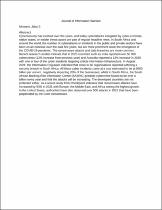JavaScript is disabled for your browser. Some features of this site may not work without it.
- ResearchSpace
- →
- Research Publications/Outputs
- →
- Conference Publications
- →
- View Item
| dc.contributor.author |
Mtsweni, Jabu S

|
|
| dc.date.accessioned | 2023-01-17T06:52:57Z | |
| dc.date.available | 2023-01-17T06:52:57Z | |
| dc.date.issued | 2022-03 | |
| dc.identifier.citation | Mtsweni, J.S. 2022. <i>Journal of Information Warfare.</i> http://hdl.handle.net/10204/12578 | en_ZA |
| dc.identifier.issn | 1445-3312 | |
| dc.identifier.uri | http://hdl.handle.net/10204/12578 | |
| dc.description.abstract | Cybersecurity has evolved over the years, and today cyberattacks instigated by cyber-criminals, nation states, or insider threat actors are part of regular headline news. In South Africa and around the world, the number of cyberattacks or incidents in the public and private sectors have been on an increase over the past few years, but are more prominent since the emergence of the COVID-19 pandemic. The ransomware attacks and data breaches are more common. Recent research studies indicate that in 2020 countries such as India reported over 50 000 cybercrimes (12% increase from previous year) and Australia reported a 13% increase in 2020 with one in four of the cyber incidents targeting critical information infrastructure. In August 2021, the Information Regulator indicated that close to 40 organisations reported suffering a security breach in South Africa. All these cyber incidents come at a cost estimated to be at $500 billion per annum, negatively impacting 20% of the businesses; whilst in South Africa, the South African Banking Risk Information Centre (SABRIC) predicts cybercrime losses to be over a billion every year and that the attacks will be increasing. The developed countries are not protected either, as a recent study from Checkpoint indicates that ransomware attacks have increased by 93% in 2021 with Europe, the Middle East, and Africa seeing the highest growth. In the United States, authorities have also observed over 500 attacks in 2021 that have been perpetrated by the Conti ransomware. | en_US |
| dc.format | Abstract | en_US |
| dc.language.iso | en | en_US |
| dc.relation.uri | https://www.jinfowar.com/ | en_US |
| dc.source | Journal of Information Warfare | en_US |
| dc.subject | Cyber defence | en_US |
| dc.subject | Cyber operations | en_US |
| dc.subject | Cyber warfare | en_US |
| dc.subject | Cybersecurity | en_US |
| dc.title | Journal of Information Warfare | en_US |
| dc.type | Other Material | en_US |
| dc.description.note | J Mtsweni was a guest editor for Journal of Information warfare vol 21(1). © Copyright 2022. | en_US |
| dc.description.cluster | Defence and Security | en_US |
| dc.identifier.apacitation | Mtsweni, J. S. 2022. <i>Journal of Information Warfare.</i> http://hdl.handle.net/10204/12578 | en_ZA |
| dc.identifier.chicagocitation | Mtsweni, Jabu S. 2022. <i>Journal of Information Warfare.</i> http://hdl.handle.net/10204/12578 | en_ZA |
| dc.identifier.vancouvercitation | Mtsweni JS. 2022. <i>Journal of Information Warfare.</i> http://hdl.handle.net/10204/12578 | en_ZA |
| dc.identifier.ris | TY - Other Material AU - Mtsweni, Jabu S AB - Cybersecurity has evolved over the years, and today cyberattacks instigated by cyber-criminals, nation states, or insider threat actors are part of regular headline news. In South Africa and around the world, the number of cyberattacks or incidents in the public and private sectors have been on an increase over the past few years, but are more prominent since the emergence of the COVID-19 pandemic. The ransomware attacks and data breaches are more common. Recent research studies indicate that in 2020 countries such as India reported over 50 000 cybercrimes (12% increase from previous year) and Australia reported a 13% increase in 2020 with one in four of the cyber incidents targeting critical information infrastructure. In August 2021, the Information Regulator indicated that close to 40 organisations reported suffering a security breach in South Africa. All these cyber incidents come at a cost estimated to be at $500 billion per annum, negatively impacting 20% of the businesses; whilst in South Africa, the South African Banking Risk Information Centre (SABRIC) predicts cybercrime losses to be over a billion every year and that the attacks will be increasing. The developed countries are not protected either, as a recent study from Checkpoint indicates that ransomware attacks have increased by 93% in 2021 with Europe, the Middle East, and Africa seeing the highest growth. In the United States, authorities have also observed over 500 attacks in 2021 that have been perpetrated by the Conti ransomware. DA - 2022-03 DB - ResearchSpace DP - CSIR J1 - Journal of Information Warfare KW - Cyber defence KW - Cyber operations KW - Cyber warfare KW - Cybersecurity LK - https://researchspace.csir.co.za PY - 2022 SM - 1445-3312 T1 - Journal of Information Warfare TI - Journal of Information Warfare UR - http://hdl.handle.net/10204/12578 ER - | en_ZA |
| dc.identifier.worklist | 26313 | en_US |






